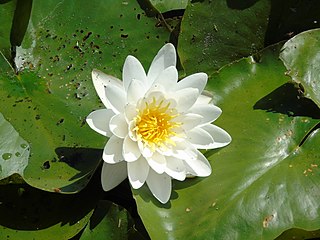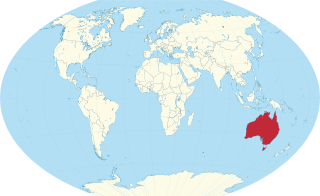
The Nymphaeales are an order of flowering plants, consisting of three families of aquatic plants, the Hydatellaceae, the Cabombaceae, and the Nymphaeaceae. It is one of the three orders of basal angiosperms, an early-diverging grade of flowering plants. At least 10 morphological characters unite the Nymphaeales. One of the traits is the absence of a vascular cambium, which is required to produce both xylem (wood) and phloem, which therefore are missing. Molecular synapomorphies are also known.

Nymphaeaceae is a family of flowering plants, commonly called water lilies. They live as rhizomatous aquatic herbs in temperate and tropical climates around the world. The family contains five genera with about 70 known species. Water lilies are rooted in soil in bodies of water, with leaves and flowers floating on or rising from the surface. Leaves are oval and heart-shaped in Barclaya. Leaves are round, with a radial notch in Nymphaea and Nuphar, but fully circular in Victoria and Euryale.

Victoria or giant waterlily is a genus of aquatic herbs in the plant family Nymphaeaceae. Its leaves have a remarkable size: Victoria boliviana produces leaves up to 3.2 metres (10 ft) in width. The genus name was given in honour of Queen Victoria of the United Kingdom.

Nymphaea is a genus of hardy and tender aquatic plants in the family Nymphaeaceae. The genus has a cosmopolitan distribution. Many species are cultivated as ornamental plants, and many cultivars have been bred. Some taxa occur as introduced species where they are not native, and some are weeds. Plants of the genus are known commonly as water lilies, or waterlilies in the United Kingdom. The genus name is from the Greek νυμφαία, nymphaia and the Latin nymphaea, which means "water lily" and were inspired by the nymphs of Greek and Latin mythology.

Nuphar is a genus of aquatic plants in the family Nymphaeaceae, with a temperate to subarctic Northern Hemisphere distribution. Common names include water-lily, pond-lily, alligator-bonnet or bonnet lily, and spatterdock.

Euryale ferox, commonly known as prickly waterlily, makhana, or Gorgon plant, is a species of water lily found in southern and eastern Asia, and the only extant member of the genus Euryale. The edible seeds, called fox nuts or makhana, are dried, and eaten predominantly in Asia.

Nuphar lutea, the yellow water-lily, brandy-bottle, or spadderdock, is an aquatic plant of the family Nymphaeaceae, native to northern temperate and some subtropical regions of Europe, northwest Africa, and western Asia. This species was used as a food source and in medicinal practices from prehistoric times with potential research and medical applications going forward.

Trithuria is a genus of small ephemeral aquatic herb that represent the only members of the family Hydatellaceae found in India, Australia, and New Zealand. Almost all described species of Trithuria are found in Australia, with the exception of T. inconspicua and T. konkanensis, from New Zealand and India respectively. Until DNA sequence data and a reinterpretation of morphology proved otherwise, these plants were believed to be monocots related to the grasses (Poaceae). They are unique in being the only plants besides two members of Triuridaceae in which the stamens are centred and surrounded by the pistils; in Hydatellaceae the resulting 'flowers' may instead represent condensed inflorescences or non-flowers.

The Zoopagomycotina are a subdivision of the fungal division Zygomycota sensu lato. It contains 5 families and 20 genera. Relationships among and within subphyla of Zygomycota are poorly understood, and their monophyly remains in question, so they are sometimes referred to by the informal name zygomycetes.

Euryale is a genus of flowering plants of the family Nymphaeaceae.
It is suggested a late Pliocene age (Reuverian) for this flora. Palynofloras from drill cores in the surroundings of Frankfurt am Main and Hanau also suggests a late Pliocene age. The Pliocene flora of Frankfurt am Main described by Karl Mädler during the first half of the twentieth century is a key flora for the European Pliocene.
The International Fossil Plant Names Index is an online database of paleobotany. The site was launched in May 2014 to list the scientific names of fossil plants, algae, fungi, allied prokaryotic forms, algal-related protists and microfossils published using binomial nomenclature.

Nymphaea carpentariae is a species of waterlily native to Queensland and Western Australia.

Susiea newsalemae was a species of plant, which occurred in the Late Paleocene period of North Dakota, USA. It is monospecific within the genus Susiea.
Microvictoria svitkoana is a fossil species of aquatic plant, which occurred in the Cretaceous period of New Jersey, USA.
Garasbahia flexuosa is a fossil species of aquatic plant, which occurred in the lower Cretaceous period of Morocco.
Euryale yunnanensis is a fossil species of Euryale from the Late Miocene of Yunnan, China.
Euryale lissa is a fossil species of Euryale from the Pliocene of Brunssum, Limburg Province, Netherlands and from Höchst, Germany.
Euryale nodulosa is a fossil species of Euryale from the Pliocene of Reuver, Limburg Province, Netherlands and Italy.
Euryale limburgensis is a fossil species of Euryale from the Pliocene of Tegelen, Limburg Province, Netherlands, from the lower Pleistocene of Greece, from the Pliocene and Pleistocene of Italy, and from the Pliocene of France.










